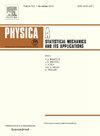Node importance corresponds to passenger demand in public transport networks
IF 2.8
3区 物理与天体物理
Q2 PHYSICS, MULTIDISCIPLINARY
Physica A: Statistical Mechanics and its Applications
Pub Date : 2025-02-01
DOI:10.1016/j.physa.2025.130354
引用次数: 0
Abstract
We investigate the correspondence between network-based public transport network (PTN) supply indicators and passenger demand at the node level, by systematically assessing correlations between node centrality measures and passenger boarding counts across different graph representations of PTNs. At the stop-level, undirected L- and P-space representations with three different edge weightings: unweighted, service-frequency-weighted, and in-vehicle-time-weighted are analysed. In each case, we calculate degree, closeness, betweenness and eigenvector centralities and examine the relation shapes. At the route level, we examine degree and eigenvector centrality for unweighted and weighted C-space representations. We introduce a modified C-space representation with self-loops, with service frequencies as self-loop weights, and propose eigenvector centrality as a route-level supply indicator. Stop- and route-level properties are integrated using the B-space representation. This methodology was applied to a case study for a bus PTN in Ljubljana, Slovenia. Results show strong correspondence between passenger demand and degree and eigenvector centrality scores in the frequency-weighted P-space (correlation ). Notably, the relationship between eigenvector centrality and passenger counts in the new C-space representation with self-loops exhibits logarithmic behaviour. Furthermore, the results suggest a minimum eigenvector centrality threshold () for a route to start facilitating passenger use. The route-level results from the B-space analysis show exponential convergence of passenger counts to route eigenvector centrality. Results of the stop-level analysis are in line with previous research and deepen the understanding of centrality measures as supply indicators. Most significantly, the route-level analysis is novel, and the results open promising venues for further research.
求助全文
约1分钟内获得全文
求助全文
来源期刊
CiteScore
7.20
自引率
9.10%
发文量
852
审稿时长
6.6 months
期刊介绍:
Physica A: Statistical Mechanics and its Applications
Recognized by the European Physical Society
Physica A publishes research in the field of statistical mechanics and its applications.
Statistical mechanics sets out to explain the behaviour of macroscopic systems by studying the statistical properties of their microscopic constituents.
Applications of the techniques of statistical mechanics are widespread, and include: applications to physical systems such as solids, liquids and gases; applications to chemical and biological systems (colloids, interfaces, complex fluids, polymers and biopolymers, cell physics); and other interdisciplinary applications to for instance biological, economical and sociological systems.

 求助内容:
求助内容: 应助结果提醒方式:
应助结果提醒方式:


